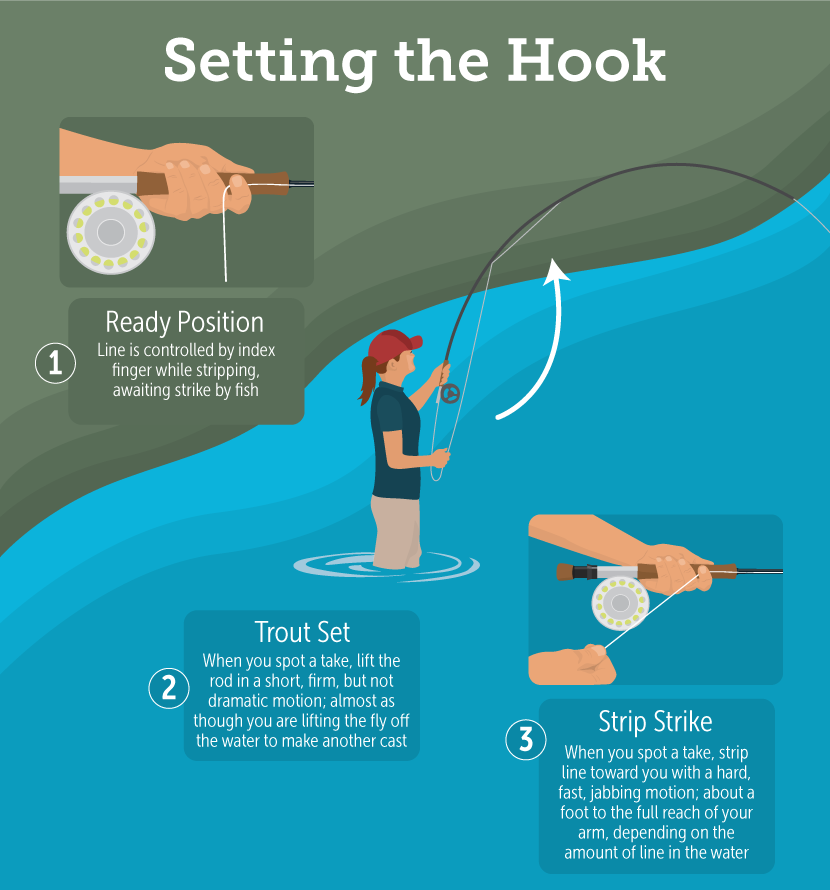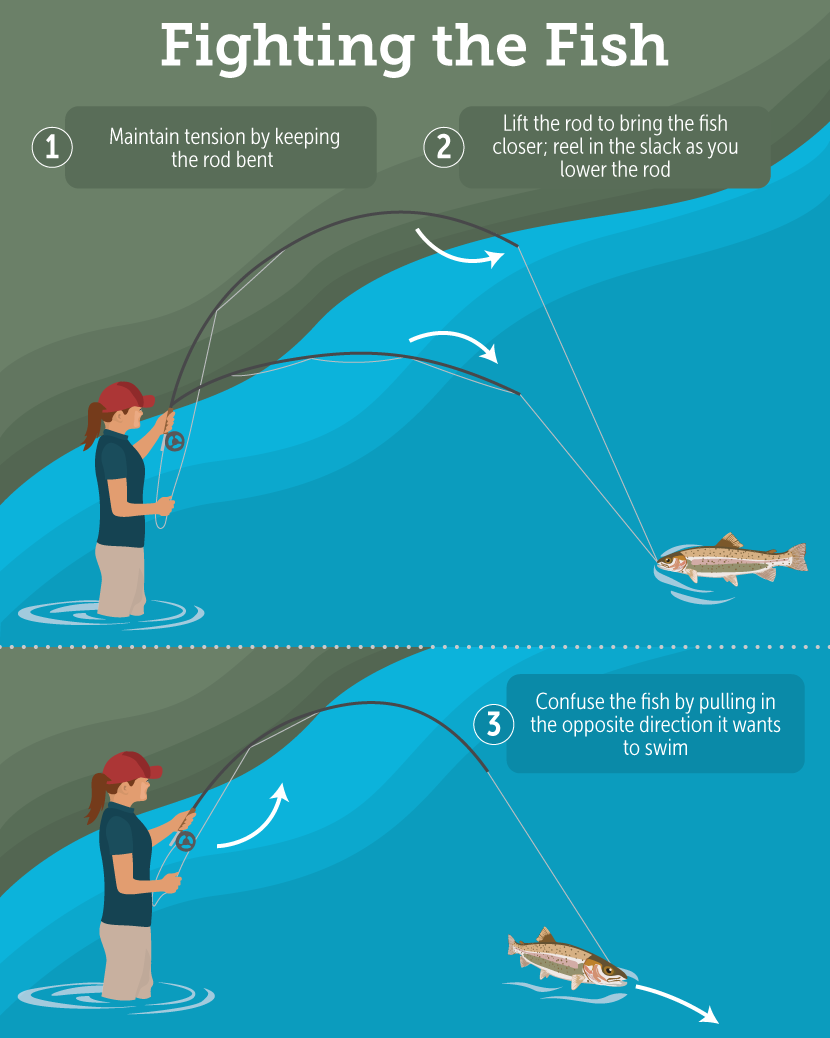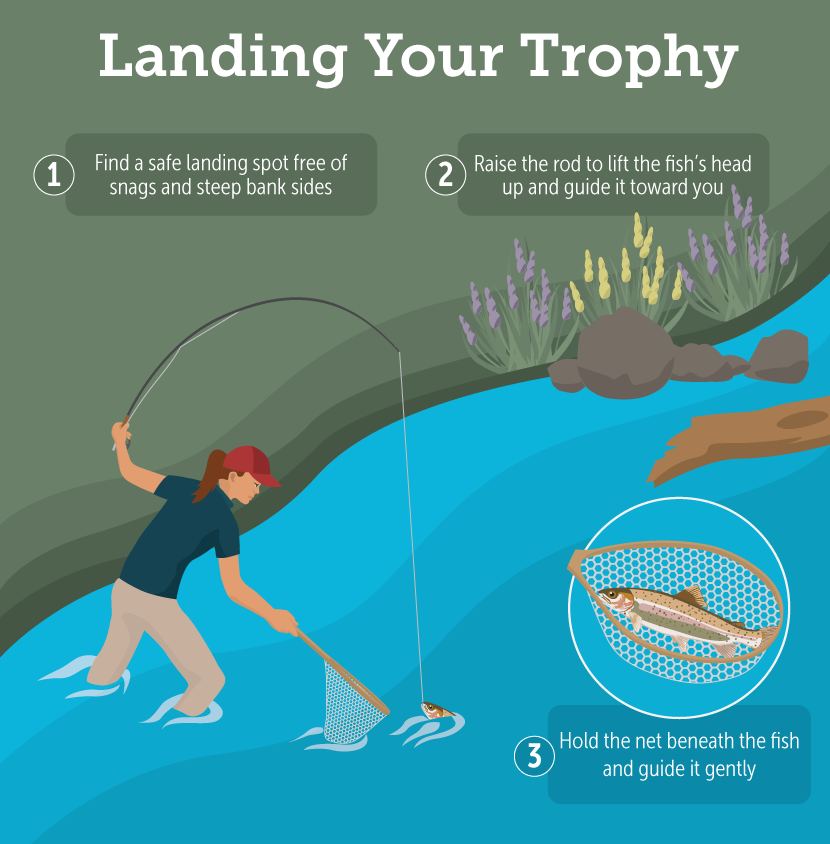How to Land More Fish With a Fly Rod
When it comes to learning how to cast, read the water, and make a presentation to fish with a fly rod, there is no shortage of information available.
But what happens when a fish eats your fly? Will you be prepared to set the hook on that first rising trout or turn that trophy bass away from his snaggy home before your tippet separates?
A large part of the fun in fly fishing is playing and landing fish with a fly rod, but there are some differences in technique and equipment that can present a challenge to the beginner fly fisher.
This article will cover the skills you need to help you hook more fish,
keep them on the line, and get them to the net so you’ll have trophies to brag about rather than stories of the one that got away.

Setting the Hook
The hook set is the most important part of the fight. It is a necessary step after a fish takes your fly that helps drive the point of the hook into the fish’s mouth and, we hope, keeps it there through the fight.
There is more to a good hook set than just rearing back and giving it to the fish. A good hook set involves timing, subtlety, and a little bit of luck.
Ready Position
Before hitting the water, you should know how to manage your line so that, when a fish strikes, you are ready to set the hook.
Ready position is simply pulling the slack out of the line after a cast and pinching the line against the cork grip and your index finger on your rod hand.
In this position, you are prepared to set the hook the moment you detect a strike. Ready position should be practiced until it becomes second nature.
Trout Set
A standard hook set for trout fishing is a simple lift of the rod once the fish has completely engulfed the fly. A sharp, upward raise of the rod is generally all you need to drive the light wire hook into the fish’s mouth.
Matching Your Hook Set to the Current Speed
In general, a slow current means that the fish will inspect the fly and rise slowly for the take. Slow down your set and allow the fish time to eat your fly and swim back down before you set.
In a fast current, fish will often rocket off the bottom and quickly attack the fly, so a swift hook set will hook more fish in this circumstance.
Matching Power to Distance
If you are fishing close in or just off the rod tip, a quick flick of the wrist is adequate for a good hook set. If you are fishing at a distance or you have a lot of slack line out, you will need to rear back with a powerful hook set to hook the fish.
Sometimes a fast lift of the rod combined with a haul or long strip of the line is necessary to come tight to the fish and recover the slack.
Setting Downstream
When dead drifting a fly below you in a downstream direction, setting the hook directly upward can often pull the fly away from the fish.
Instead, sweep the rod sideways toward the bank in a downstream direction. This will help set the hook into the corner of the fish’s mouth and keep the fish on the line.
Strip Strike
The strip strike is a specialized hook set normally used when fishing streamers and other flies with an active retrieve.
When you feel the fish strike, keep the rod pointed right at the fish and pull the line hard with your stripping hand to tighten the line and pull the hook into the mouth of the fish.
If you miss the take, keep stripping the fly in. Often, the fish will come back for another shot if it didn’t feel the point.
The Fight
Once you have a fish hooked, you need to be able to bring it to hand. If you are unprepared, a large or feisty fish can easily throw the hook or snap your line, leaving you wondering what went wrong.

Make a Plan
Anglers who have caught and released many trophy fish know that planning beforehand is the best way to prepare for what is sure to be a tough battle.
Before making the cast, visualize the fight. Look for any hazards along the bank or snags in the water that could cause a problem.
Think about where the fish is likely to swim and what direction you should pull to guide the fish away from potential threats.
Often, a big fish will immediately head for a nearby structure or deep water. Plan accordingly, and you will have a greater chance that the fish will swim into your net.
Don’t Slack Off
Fly fishermen often use small, barbless hooks. If there is any slack in the line during the battle, the fish can easily shake the hook and get away.
Practice keeping the line tight at all times. If the fish swims straight at you, strip by hand or reel to recover the line quickly.
Pay attention to what the fish is doing and keep a slight bend in the rod to maintain tension.
Lower is Better
You will often hear people telling you to keep the rod high when fighting a fish. Don’t listen to them. A high rod tip puts very little pressure on the fish and allows them to exert their will.
It also encourages a fish to jump and throw the hook. Generally, keeping the line tight and fighting with the rod at a 45-degree angle or less will help you land more fish.
A low rod angle allows you to take advantage of the full flexing power of the rod to put pressure on the fish and absorb any hard runs or head shakes.
You will keep more fish on the line and land them faster by fighting with a low rod angle.
Pump the Rod
When fighting a big, stubborn fish, recover the line quickly by pumping. Pull the fish toward you by lifting the rod, and then lower the rod while simultaneously reeling in the slack line. Repeat this motion to keep the fish moving toward you.
Bow to the King
During a fight, a fish will often take to the air to try to dislodge the hook from its mouth. When this happens, lowering the rod will lessen the fish’s leverage and reduce its chance of throwing your fly.
Lead the Fish
Confuse the fish by switching the direction of pull back and forth to always lead it in the opposite direction it wants to go. Constantly changing directions will tire it out quickly and finish the fight faster.
The first few seconds of the fight are often the most crucial. Trust your tackle, your hook set, and your fighting abilities. Don’t jerk the rod or lose your cool.
Sometimes we lose a good fish and it just wasn’t in the cards, but staying calm and keeping the pressure on the fish will greatly increase your chances of winning the battle.
Landing Your Trophy
You may think you have your fish whipped and you’ve brought it in close enough to touch, but the fight isn’t over yet! One wrong move, and that fish will be swimming right back into the depths. Here’s how to finish the fight and get that trophy to hand.

Watch Your Leader
Avoid bringing your line into the rod past the leader connection. The rough connection between your leader and the rod is prone to snagging on the rod tip or in the guides, which could result in a broken rod, a broken leader, a lost fish, or all of the above.
Find a Good Landing Spot
As soon as you hook your fish, you should be looking for a place to land it. In a river, it often helps to work your way downstream of the fish to an area where the current is slow and ideally the bank is flat.
The fish will be forced to either fight upstream against the current or drift down to your waiting net. Look for an open area with few bank side snags or other hazards.
The last thing you want is to lead your trophy right into a tippet buster after you worked so hard to hook and fight it.
Heads Up
When the fish becomes tired, bring it in close and raise the rod to lift its head out of the water. This takes most of its fighting power away and allows you to gently glide the fish across the surface into your net.
Use a Net
Whenever possible, use a net, preferably with rubber mesh. This will allow you to land the fish safely and easily while reducing the chance of breaking the tippet at the last second.
Avoid jabbing the net at the fish. Instead, hold the net in the water below the fish and guide the fish gently to the net.
If you are practicing catch and release, it will also help you keep the fish in the water while unhooking it or preparing your camera for a photograph.
Less stress on the fish means a healthy release and a fish that lives to fight another day.
Remember these tips next time you hit the water and you will have a greater chance of bringing more fish to the net. Don’t forget to keep that fly in the water. The next strike you get might be the fish of a lifetime!
Embed the article on your site

